Over the past decade, video content has grown to become an essential part of the modern-day digital society. Many businesses have changed their marketing strategies by incorporating videos to communicate better with their target audience. Videos offer an easily consumable format that caters to on-the-go users, while also providing flexibility, value, and relevance.
But videos aren’t just great for engaging people and getting them to pay attention to your company’s offerings and profile. Videos can also improve your SEO and website rankings.
The key question is: how exactly do videos contribute to boosting your SEO efforts?
In this post, we’ll explore the significance of video content in improving your SERP rankings. But before getting to that, let’s discuss why videos are in such high demand.
Why videos are popular
Videos are short and sweet
Videos have become the go-to form of content due to their effectiveness at delivering tons of information in a short and concise format. Research by Bitable suggests that one minute of video equates to approximately 120-200 words, with an average of 160 words. This implies that a text of 1500 words can be condensed into a video lasting around 10 minutes. It’s also true that users will be more willing to watch a 10-minute video than read an article of similar length.
But be careful with long videos. According to Vidyard’s research, the average retention rate of videos is 52%, but it varies based on the video’s length. For instance, videos under one minute tend to have a retention rate of around 68%. On the other hand, for a 20-minute-long video, only 25% of viewers are likely to watch it to the end.
So even though creating videos is an effective and attention-grabbing way to convey information, it must be approached wisely.
Videos are great for storytelling
In addition to being packed with information, videos tell stories, which is why they tend to stick in people’s minds longer than cold, hard facts. Moreover, Wyzowl’s report on video marketing shows that 89% of 528 unique respondents admit that watching a video persuaded them to buy a service or product.
Do you remember The Farmer’s ad that was released during the Super Bowl in 2023? This ad did a great job at captivating its audience and taking them on a short, but emotional journey. It hit everyone right in the feels!
Videos improve user experience
Videos focus on the user experience. They communicate everything that people like by seamlessly blending together visuals, sounds, and movement. Plus, videos can easily be watched on mobile phones, which aligns with the growing trend of mobile video consumption among users. In fact, more than 60% of respondents in the U.S. used their smartphones to watch videos. And on average, U.S. adults spend over 50 minutes a day watching mobile video content.
Another example of a short, but impactful video is brought to us by Amazon.
The ad features a family at home during the lockdown with their adorable that they rescued from a shelter. But then the lockdown ends, and everyone returns to their usual activities outside the home. Sadly, the begins to feel lonely.
To address this, Amazon created a separate page on its website, narrating the story of the rescued , and how Amazon played a role in helping overcome its loneliness.
The popularity of videos definitely will not be losing momentum anytime soon. Experts predicted in 2018 that more than 80% of all consumer traffic would be videos by 2022. Though the reality isn’t as high, the video consumption trend is clearly on the up swing. Recently, the intelligence firm Sandvine released a report after collecting data from 177 service providers worldwide. The report discovered that video usage grew by 24% in 2022, and videos now constitute 65% of all internet traffic.
And with so many eyes constantly directed at videos, a phenomenon aided by the widespread use of mobile devices and smart speakers like Google Home, along with emerging technologies like voice search, video content is bound to bring in positive business results.
How Google adapts to the growing popularity of videos
In response to all these user behavior trends, Google took action in 2013 by releasing a new search algorithm called Hummingbird. This algorithm shifted the focus from keywords to understanding the user’s intent behind their search query.
So, what did this mean for videos? Well, they started appearing more often in search results, with around 606.7K of SERPs in the US now showing videos.
During the early stages of Hummingbird’s launch, video SERP features were still developing. But when video carousels were being rolled out in June 2018, these features incorporated some of the underlying principles of Hummingbird’s semantic search. Today, video SERP features are more prominent and effective in delivering relevant video results to users, and they play a key role in Google’s search ecosystem.
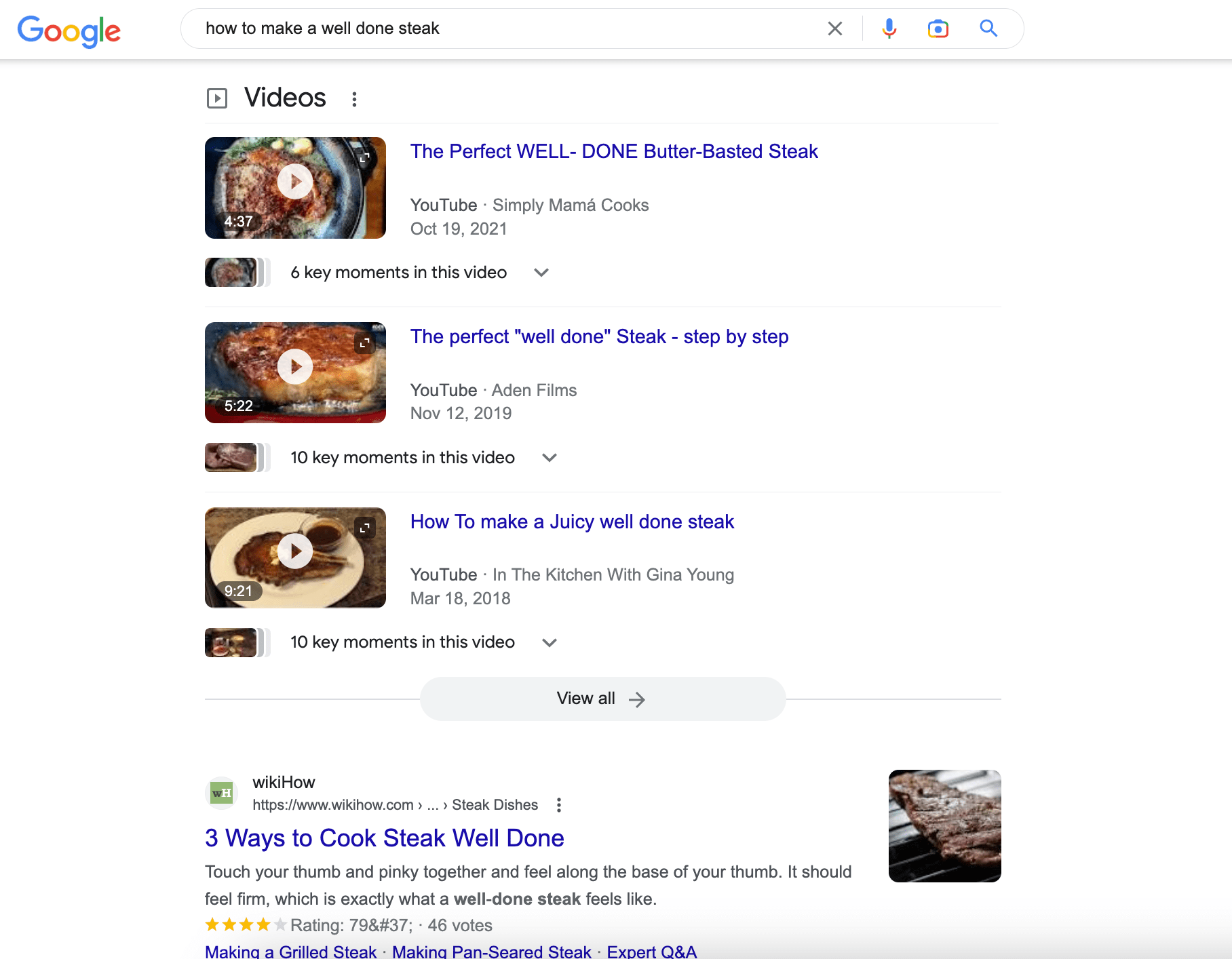
Since people prefer watching videos, Google tries to display them on SERPs whenever relevant, particularly for informational and educational queries such as those that start with “What is” or “How to.” When creating a video, think about what question it answers. For such queries, videos can be featured as a Suggested Clip, an Instant Answer, or a Video SERP Feature.
Give it a go yourself, assuming you haven’t already done it a billion times. Ask Google how to remove a SIM card from an iPhone, how to make an apple pie, or how to use AirPods. Chances are that Google will return at least one video result.
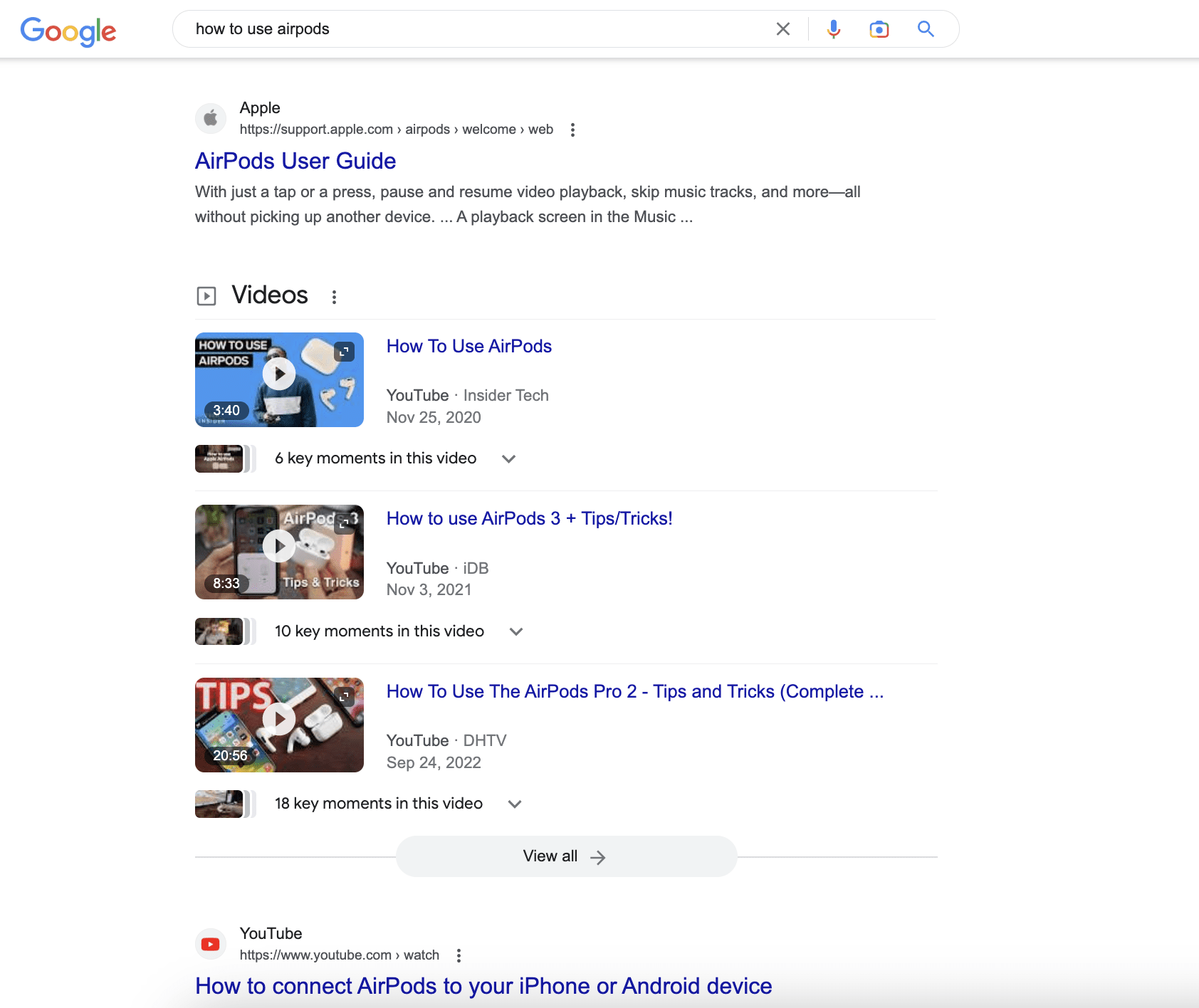
As you can see in the example above, Hummingbird takes into account the user’s intent when presenting search results, and so should you. If your video offers a relevant, valuable answer to a specific question, there’s a good chance it will appear in the blended search results.
Now that we can see why videos are so well received and acknowledged by search engines for their popularity, let’s look at how you can leverage videos to improve your SERP rankings.
How videos can help boost SERP rankings
First and foremost, let’s clarify one thing: simply adding a video to your webpage won’t boost your rankings. That’d be too easy. The impact of videos on search rankings calls for a more nuanced approach.
So, without any delay, let’s look at how the presence of a video on a webpage can impact its SERP rankings.
1. Longer dwell time & lower bounce rate
When a new visitor lands on your website, you don’t have much time to capture their attention and convince them to stay. This is where videos can make a major impact.
The engaging nature of video content, as opposed to images and text, tends to hold people’s attention for longer periods. In fact, it has been reported that people spend 1.4x more time on pages with video content than on pages without videos.
From the standpoint of SEO, this is a big deal. The longer a visitor’s session or “dwell time”, the higher your chances of getting search engines like Google to see the value of your video and the trustworthiness of the webpage it’s hosted on. This can contribute to a higher page ranking.
And, naturally, if people spend a lot of time on your content, they are more likely to explore your website and see what your other pages have to offer. This not only increases pageviews but also brings down the bounce rate.
The bounce rate is a common challenge faced by many websites. With so many choices online, distracted users will oftentimes leave a page within seconds if they don’t instantly find what they’re looking for. This is where videos can serve as an anti-bounce tool. After all, unlike written text, you must watch a video, or at least part of it, to learn what it’s about.
Here’s an example of a video by Dutch drinking water supplier Oasen. You’ll notice that the video is placed prominently above the fold in the background of their homepage.
This video creates an immersive experience, giving the impression that the entire website is interactive and enticing visitors to explore it a bit further. It’s a clever tactic that adds extra value to the overall website experience.
The Yacht Company offers another great example of a background video. You can almost get lost exploring the beautiful scenery and landscapes portrayed in their videos. It’s also worth mentioning that the video content on their site extends beyond their homepage, so there’s plenty for visitors to check out.
If you’re facing challenges with low rankings and you’re struggling to engage visitors, resulting in low dwell time and a high bounce rate, featuring an above-the-fold video on your webpage can do the trick.
2. Increased click-through rate
When people search for information on Google, they tend to click on results that include videos. By indicating to search engines and users that your webpage contains a video directly on the SERPs, you can increase the click-through rate and drive way more traffic to your site.
Google occasionally updates its SERPs to provide users with more info about websites and their content. This information is presented through rich results, also known as rich snippets. Rich snippets are designed to help people understand what they will find on a page before they click on it.
You can check whether your page with a video has rich snippets by using SE Ranking’s Rank Tracker. Once you add your project to the platform, open the Rankings tab and go to the keyword table. If your page with a video appears in video results, you’ll see that the video icon has turned blue.
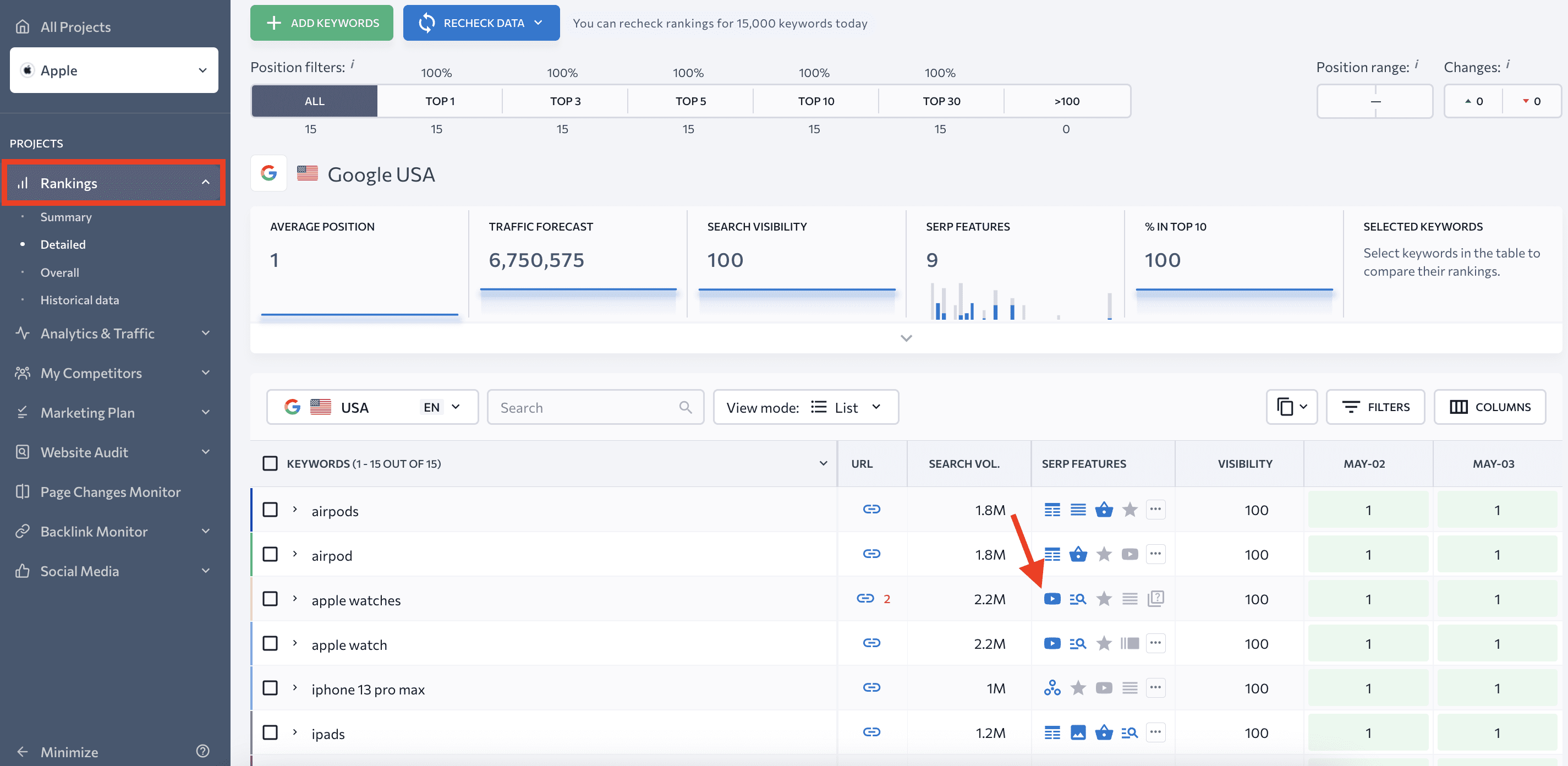
In addition to providing Google with textual information about the video, it’s important to have a visually appealing thumbnail for your video. Thumbnails play a crucial role in the click-through rate on the SERPs because humans are naturally drawn to beautiful and captivating images.
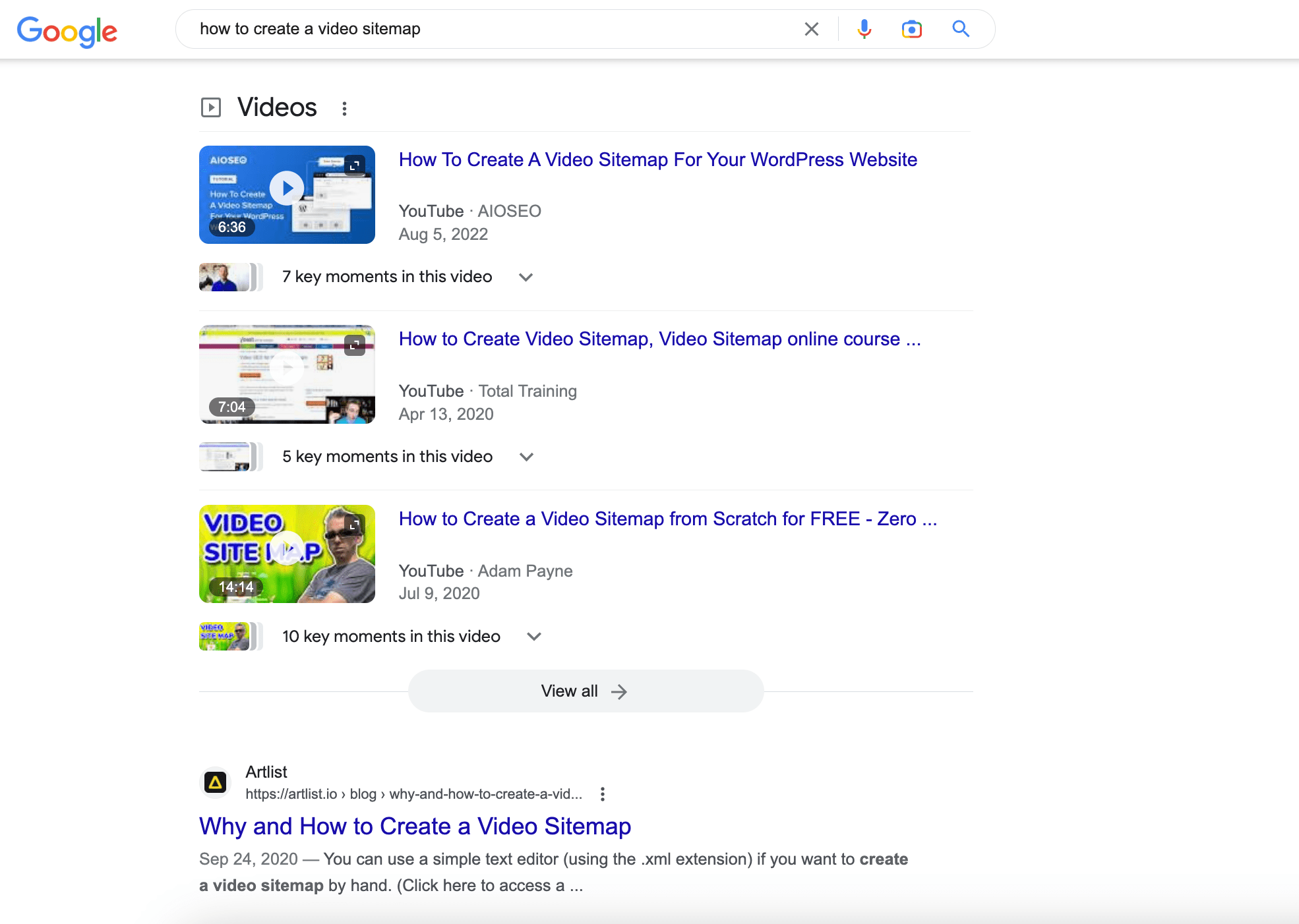
When looking at the picture above, which video result would you click on first? Would you choose the second one (with a blurry thumbnail that doesn’t reveal the topic of the video)? Or the first and third ones (both saying what they are about)?
It’d be a real shame if your amazing video didn’t receive any clicks, traffic, or engagement just because you didn’t create an eye-catching thumbnail.
3. Improved backlink profile
People **** sharing amazing content, so if your video strikes a chord with viewers, they are more likely to link to it, which is another vital ranking factor. As your high-quality and unique video circulates the web, it will naturally get backlinks to the page where the video is hosted.
Just look at the example below: Dior’s ad on the spring-summer 2023 women’s campaign is getting a lot of buzz online and, as a result, it’s getting frequently referred to in various posts. It just goes to show that a quality piece of content can go a long way.
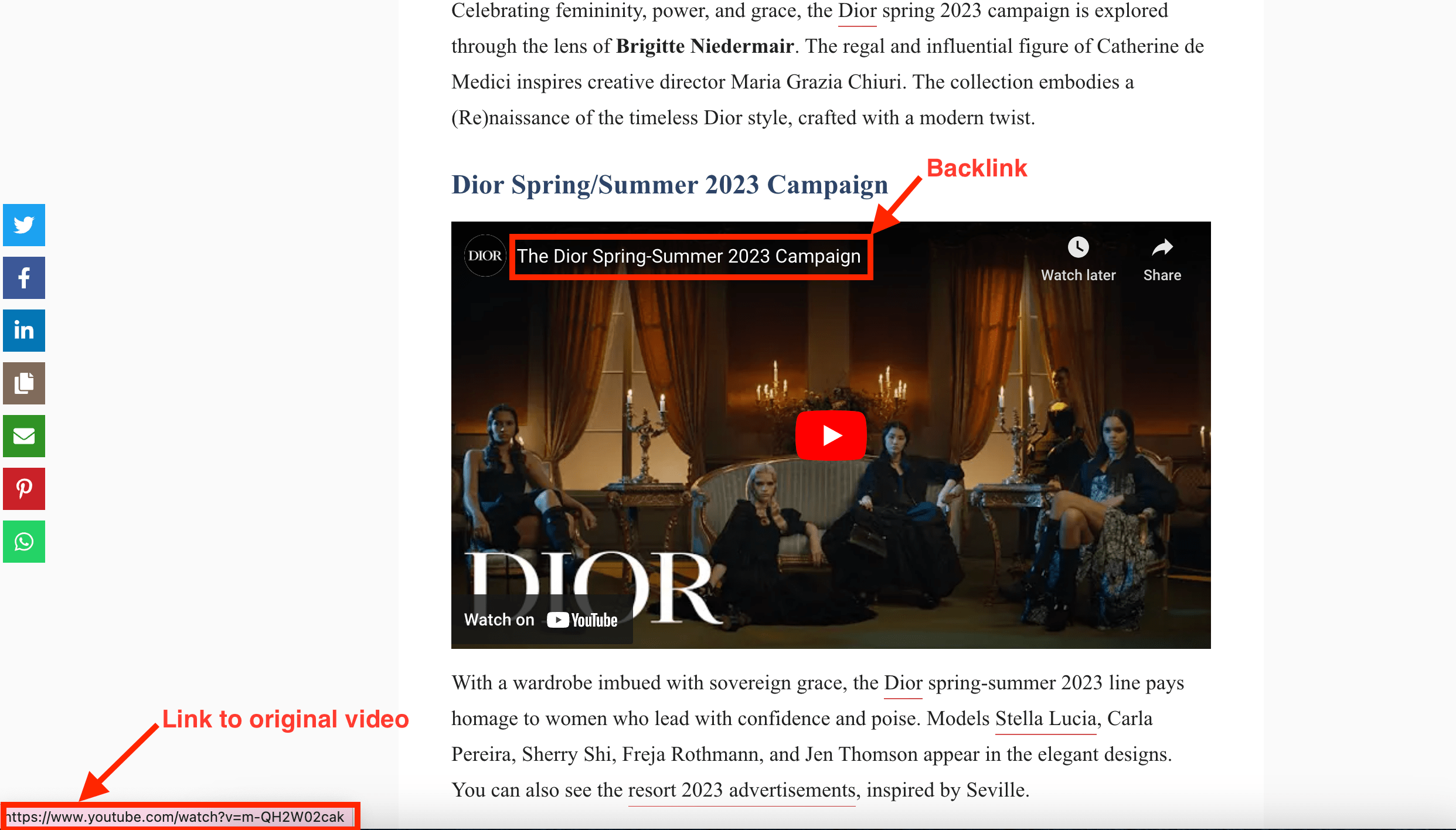
If you upload your video to a third-party platform like YouTube, you can earn backlinks and qualified referral traffic by adding a link to your website in your channel information or video description.
Similarly, if you host the video on your own website, you can still benefit from backlinks and outreach. If the video is of top-notch quality, people will link out to it no matter where it’s hosted.
And even if your videos don’t directly drive more people to your website, you can boost brand awareness and search visibility by including your logo in your videos. This will increase your brand authority in the eyes of search engines.
You can check which websites link back to the pages with your videos by using SE Ranking’s Backlink Checker.
Just paste the URL of the page with the video into the tool and choose the URL as the domain type. Then, hit the Search button.
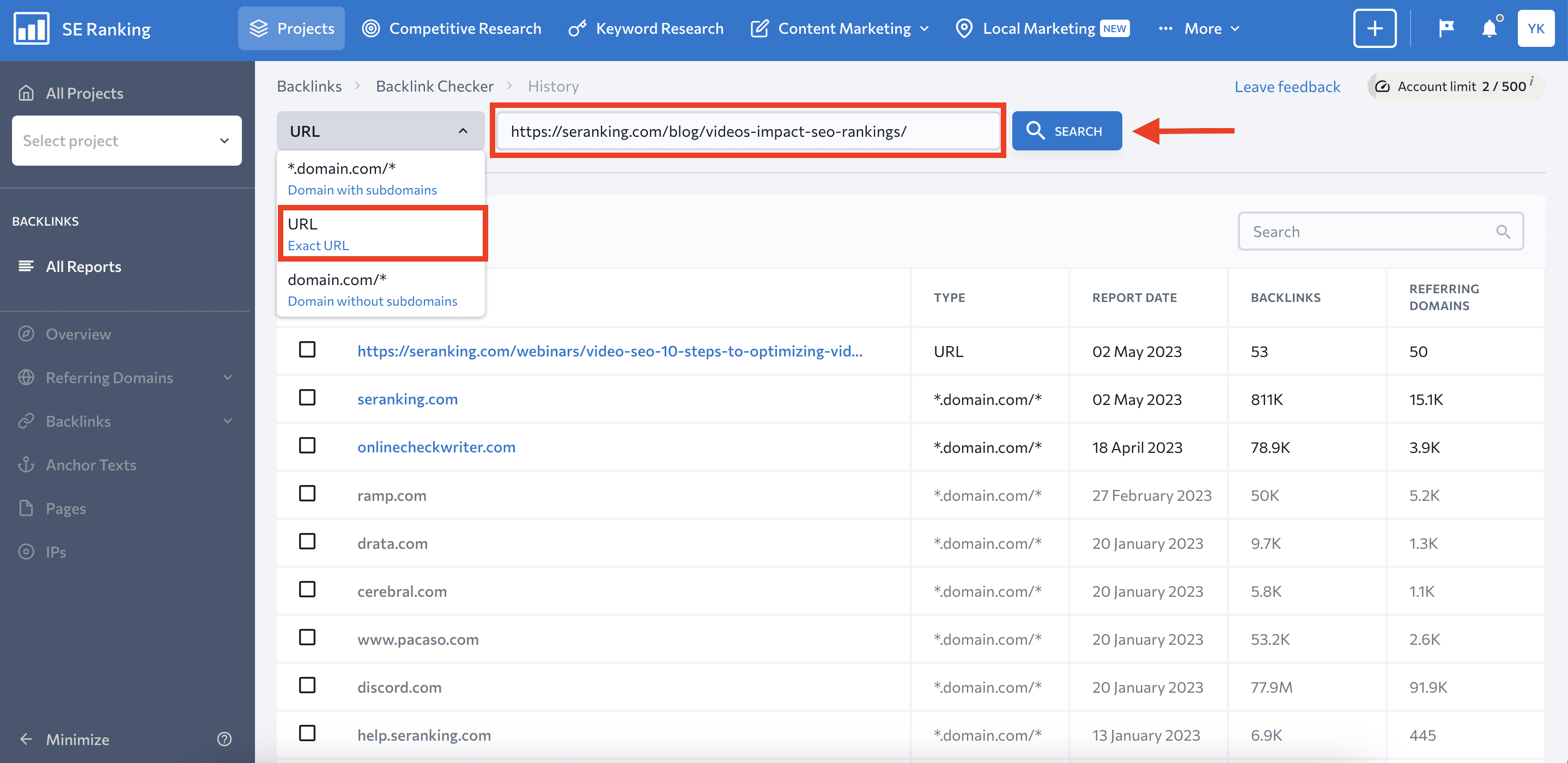
The tool will collect all the backlinks and referring domains pointing to the page with your video on it and analyze them against 15 parameters. You’ll be able to see any active/new/lost backlinks as well as their:
- Domain trust score
- Page trust score
- Total traffic
- Anchor text
- Link type
- First and last seen dates
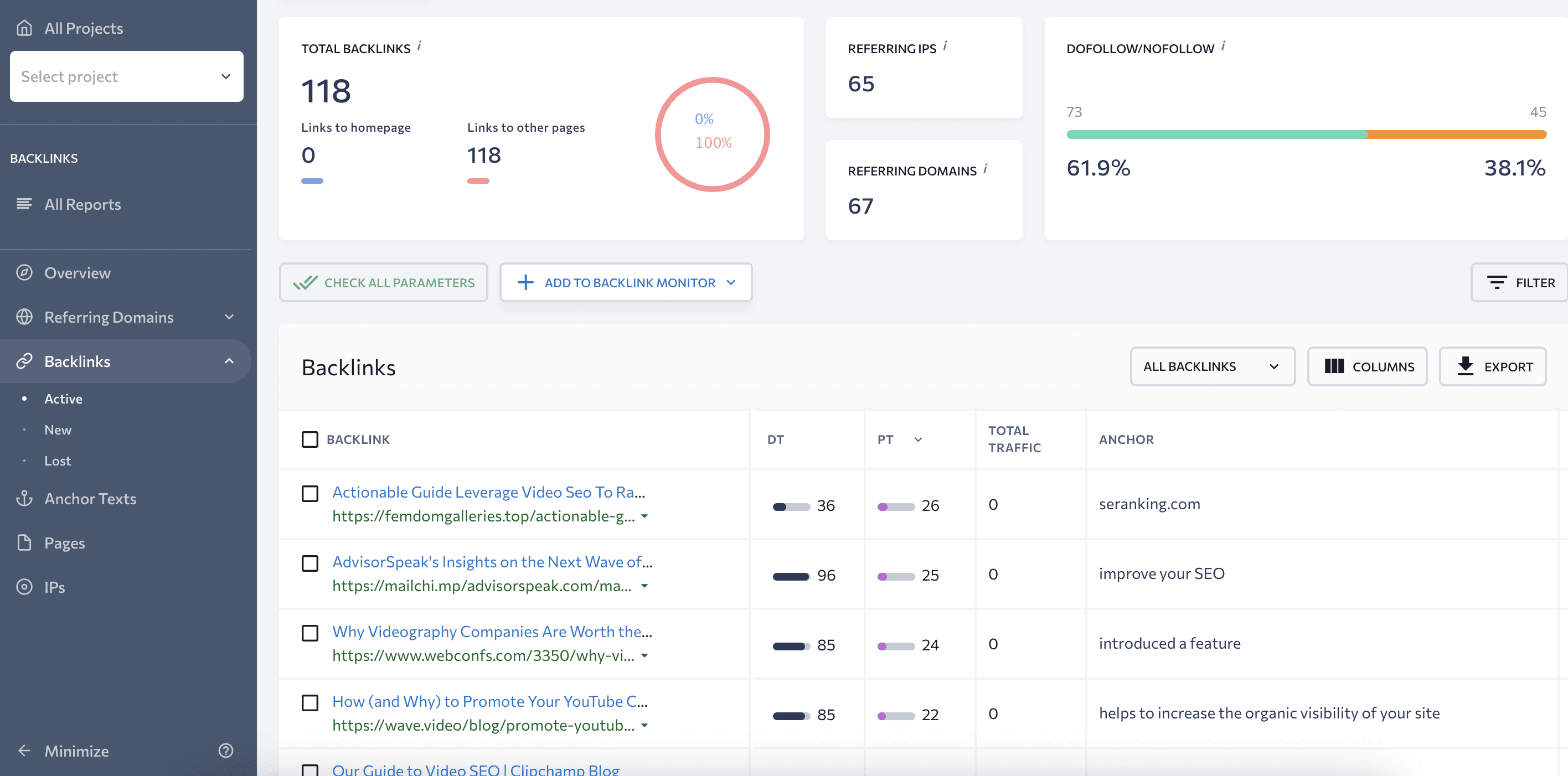
To take a closer look at the website linking to your videos, go to the Referring Domains tab. Here, you’ll see a list of referring domains, including their names, domain trust, number of backlinks, and first-seen ****. If you click on the number of backlinks a certain domain sends to your website, you’ll see where exactly they come from, their Domain and Page Trust scores, anchor text, and more.
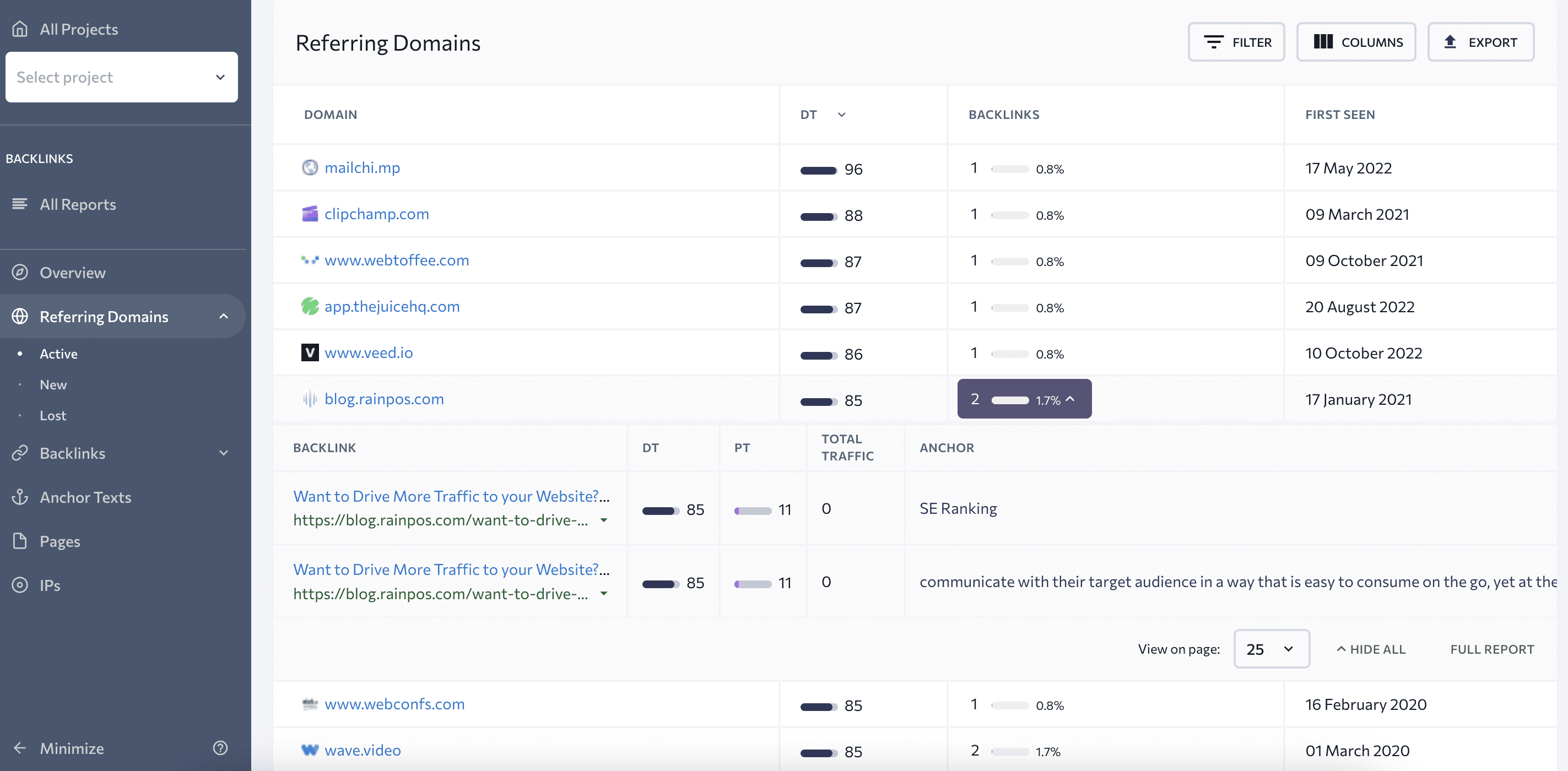
4. Google Business Profile listings
Google likes brands that take full advantage of Google Business Profile listings and rewards those that do with a spot in the Local Pack.
Local business listings that include images, posts, and messages are already known to rank higher. Imagine the impact adding a video would have on getting your GBP listing ranked in the Local Pack.
To take advantage of this opportunity, create an appealing video that explains what your business is all about or that demonstrates your service/product in under 30 seconds. By adding this video to your GBP page, you’ll have an edge over competitors who didn’t make use of this opportunity. But first, make sure to verify your GBP profile.
Including visual information in your GBP listing helps people “get to know” your business. It is believed that the more recent your photos or videos are, the higher the likelihood of getting clicks to your website. Visual content also helps to engage users who see your listing, and Google keeps track of the interactions that take place with it.
Polishing your GBP is an essential aspect of any local marketing strategy. A well-optimized GBP can improve a business’s visibility, attract potential customers, and increase the chances of converting them into loyal customers.
Along with videos, your GBP should include accurate and up-to-**** information about the business, including its name, address, phone number, website, hours of operation, customer reviews, etc. If you provide incorrect information, then the video in the profile will not make much sense.
You can check your GBP optimization and track its performance with SE Ranking’s new Local Marketing tool. It informs you about any GBP issues and lets you:
- Manage GBP and other listings data.
- Manage and respond to reviews.
- See how users interact with your GBP.
- Get insights into keywords used in reviews.
- Analyze your listings across different platforms.
- And much more.
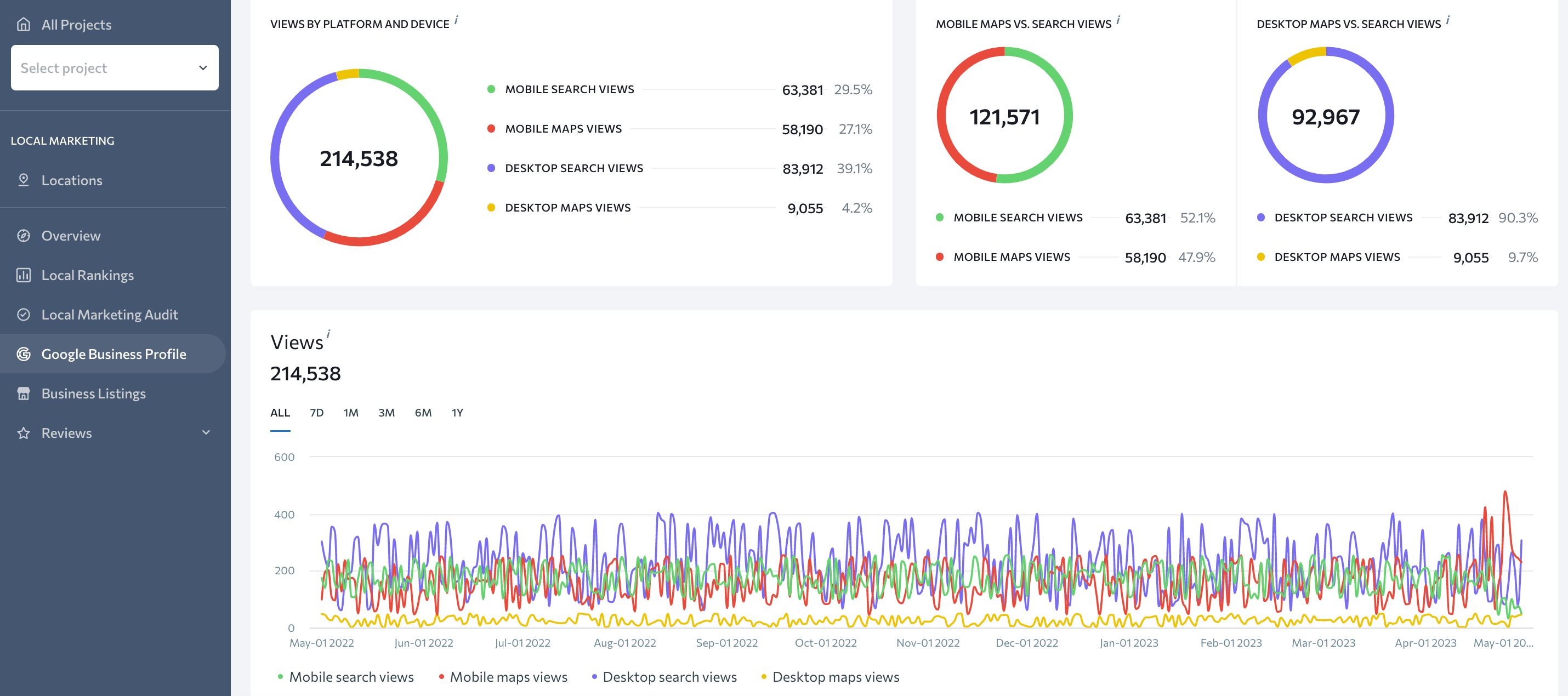
Other things you should know about video and SEO
How to get your videos indexed
To get your videos indexed by search engines, provide bots with metadata about your videos. This helps search engines understand your video’s content and context. Make sure that for each video, you specify its:
- Title
- Description
- Length
- Upload ****
- Video file location/embeddable player
- Thumbnail image
You can provide metadata for your video content using a video XML sitemap. Submitting it to search engines ensures that your videos are being crawled and indexed. You can send your video sitemap through Google Search Console or include a sitemap link in your robots.txt file. You can also add video metadata to the page hosting the video using Schema.org markup.
Where to host a video: on your website or YouTube?
When deciding whether to host a video on your website or YouTube, consider the following factors:
- Hosting on your website gives you complete control over the content and branding. You can customize the video player, add your branding, and control the user experience. With YouTube, your video is hosted on a third-party platform, giving you less control over the user experience and branding, and you must comply with their policies.
- YouTube is the second-largest search engine after Google and has a massive user base. Hosting your video on YouTube can reach a broader audience and increase visibility. Hosting videos on your website may limit the potential reach.
- Hosting on YouTube can help improve your website’s SEO by increasing traffic and backlinks. YouTube videos often rank high in search engine results.
- Hosting a video on your website can be more expensive due to the additional server resources and bandwidth required.
There are pros and cons to both options, so consider your goals and needs. You can also host videos on both YouTube and your site to maximize the reach and impact of your video marketing efforts.
Since Google owns YouTube, does hosting videos on it guarantee higher rankings?
While Google does own YouTube, uploading your videos to YouTube alone doesn’t guarantee better search engine rankings for your website. Using YouTube to host your videos doesn’t give you any ranking advantage on Google, just like using Google web hosting or any other Google product.
Anything you upload on YouTube is automatically indexed by the YouTube algorithm and not the Google bot. If you embed a YouTube video on your website, its rankings are not directly influenced by being hosted on YouTube, but its level of optimization will influence rankings.
How does adding transcripts to videos affect SEO?
Video transcripts are text-based versions of a video’s spoken content. Adding them to your videos can benefit your SEO in several ways:
- Transcripts make your videos more accessible to people who are deaf or hard of hearing.
- Transcripts can improve the user experience by allowing users to scan the content and find the information they need quickly.
- Transcripts help search engines understand your video content better and can improve your search engine rankings. Search engines can’t watch videos, so they rely on text-based content such as transcripts and captions to understand what your video is about. Adding relevant keywords can also make your video more relevant to search queries.
Adding transcripts isn’t mandatory, but they can improve the visibility of your videos.
Wrapping up
Because of the immersive nature of videos, their use and popularity will only continue to grow in the near and distant future. People simply prefer watching videos. They engage with videos more often and tend to remember them, which indicate two engagement metrics that every marketing strategy wants to see success in.
But you should always make sure that you don’t only use videos for their marketing potential, but also for their SEO advantages. Videos have repeatedly proven their ability to boost the online visibility of brands, generate more traffic, and improve website rankings in the eyes of search engines.
Now that you know why videos are worth including in your strategy, the next step is to learn how to make them more visible in the SERP. Check out our guide on combining video marketing and SEO, and watch our webinar on video SEO. Get ready to increase traffic and rankings for your website!


